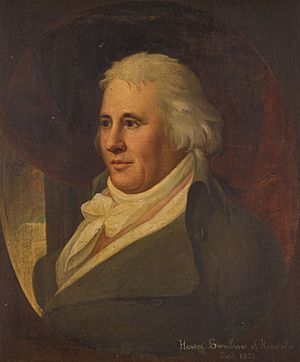Henry Swinburne facts for kids
Quick facts for kids
Henry Swinburne
|
|
|---|---|

portrait by Anton Hickel, 1794
|
|
| Born | 8 July 1743 Bristol, England
|
| Died | 1 April 1803 (aged 74) Trinidad, Trinidad and Tobago
|
| Occupation | Travel Writer |
Henry Swinburne (1743–1803) was an English travel writer. He explored many parts of Europe, especially Spain and Italy. He wrote popular books about his journeys. These books helped people in England learn more about other countries.
Contents
Early Life and Education
Henry Swinburne was born in Bristol, England, on July 8, 1743. His family was Catholic. His father, Sir John Swinburne, died when Henry was young. Henry went to school at Scorton in Yorkshire. Later, he studied in France at a school called La Celle. He also studied in Paris, Bordeaux, and Turin. He was very interested in literature and art.
Henry's brother left him a small estate in Hamsterley, Durham. This gave Henry some money to live on. He then traveled to cities like Turin, Genoa, and Florence in Italy.
Marriage and Family Life
While in Paris, Henry met Martha Baker. She was the daughter of John Baker, a lawyer from Chichester. Martha was studying at a convent. Henry and Martha got married in Aix-la-Chapelle on March 24, 1767. After their wedding, they moved to Hamsterley. Henry spent time making the estate look nice.
Adventures as a Traveler
Henry and Martha loved to travel. In 1774, they spent time in Bordeaux, France. Then they visited the Pyrenees mountains. Henry also traveled through Spain with a friend, Sir Thomas Gascoigne. He wrote down everything he saw.
His notes became a book called Travels through Spain, 1775 and 1776. It was published in 1779. The book included drawings of old Roman and Moorish buildings. This was the first book in England to focus on the ancient history of Spain.
After Spain, Henry and his family sailed to Naples, Italy. They explored the Two Sicilies region for a few years. Henry wrote another book about these travels, Travels in the two Sicilies, 1777-1780. This book also had many drawings.
Life in Europe's Courts
When the Swinburnes returned to England in 1779, they didn't stay long. They soon traveled back to Europe. They visited Vienna, Austria, and became friends with important people. The Empress of Austria, Maria Theresa, gave Martha a special award. The Emperor, Joseph II, even became the godfather to one of their sons.
Henry also spent time in Paris, France. He became a favorite of Marie-Antoinette, the Queen of France. She helped him get a large piece of land in St. Vincent in the West Indies. However, this land later caused him some financial trouble.
Later Years and Work
In 1796, Henry Swinburne went to Paris again. His job was to arrange an exchange of prisoners with France. But this was a difficult task, and he was called back to England in 1797.
In 1801, he got a new job in Trinidad, a newly acquired British territory. He was also a commissioner, helping to hand over some Danish islands to Danish officials. Sadly, Henry Swinburne died in Trinidad on April 1, 1803, from sunstroke. He was buried in San Juan. His friend, Sir Ralph Woodford, built a monument to remember him.
Henry Swinburne's letters about his travels and life in Europe were published after his death. They offer a look into the royal courts of Europe in the late 1700s.
Family Life
Henry Swinburne and his wife Martha had ten children: four sons and six daughters. Many of their children also led interesting lives.
One of their daughters, Mary Frances, married Paul Benfield. Another daughter, Carolina, married Richard Watt Walker. Maria Antonia married Major-General Oliver Robert Jones. Harriet married John Walker, and their son, Frederick Walker, later moved to Australia.
One of their daughters, Louisa, became good friends with Princess Elizabeth of the United Kingdom. Louisa died in 1848.
Their eldest son, Henry, died as a baby. Another son, also named Henry, died in a storm at sea in 1800. Their third son, Thomas, was a naval officer who died in a shipwreck in 1806.
Works
Henry Swinburne's main works include:
- Travels through Spain, 1775 and 1776 (published 1779)
- Travels in the two Sicilies, 1777-1780 (published 1783-1785)
- The Courts of Europe at the close of the last Century (published 1841, based on his letters)
See also
 In Spanish: Henry Swinburne para niños
In Spanish: Henry Swinburne para niños

